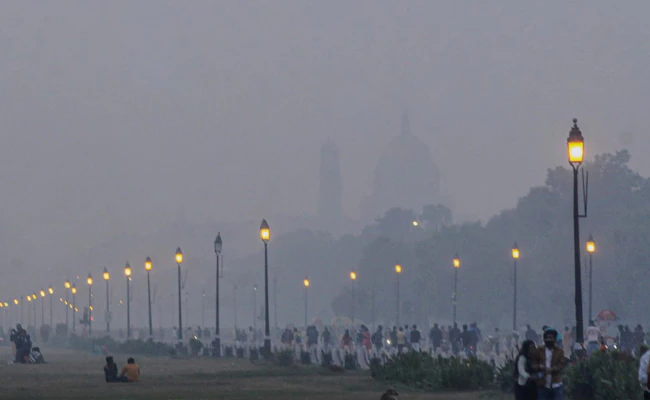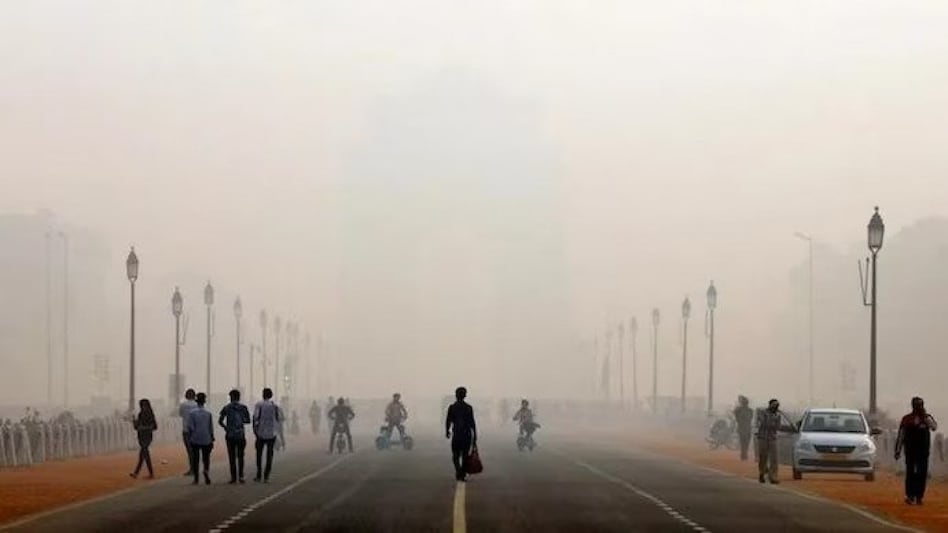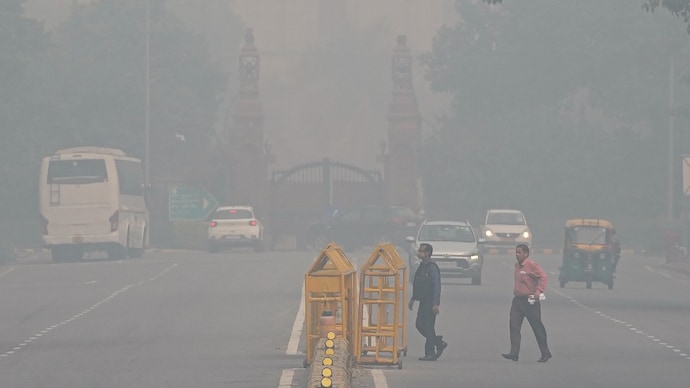Delhi’s Air Quality Plunges to ‘Severe’ Levels with AQI Surpassing 400 Post-Diwali

Delhi’s Air Quality Plunges to ‘Severe’ Levels with AQI Surpassing 400 Post-Diwali
As the festive fervor of Diwali settles, Delhiites are waking up to a harsh reality – the air quality in the national capital has nosedived to ‘severe’ levels. Just two days after the celebration of lights, the Air Quality Index (AQI) in several locations breached the ominous 400-mark, sending alarming signals about the gravity of the air pollution crisis in the region.
In the early hours of Tuesday, the Central Pollution Control Board (CPCB) reported staggering AQI figures, with ITO recording 424 and the vicinity near Indira Gandhi International (IGI) airport registering 426 at 8 am. This revelation has once again thrust the issue of air pollution to the forefront, demanding urgent attention and collective action.
The annual post-Diwali air quality dip is not new to Delhi; however, the severity of the situation this year raises concerns about the effectiveness of measures implemented to curb pollution and protect public health. In this article, we delve into the factors contributing to Delhi’s worsening air quality, the immediate consequences on public health, and the potential long-term solutions needed to address this persistent challenge.

Understanding the Air Quality Index (AQI): A Gauge of Pollution Severity
Before delving into the specifics, it is crucial to comprehend the significance of the Air Quality Index. AQI is a numerical scale that communicates the concentration of various pollutants present in the air and classifies the overall air quality into different categories ranging from ‘Good’ to ‘Hazardous.’ The scale includes pollutants such as particulate matter (PM2.5 and PM10), nitrogen dioxide (NO2), sulfur dioxide (SO2), carbon monoxide (CO), and ozone (O3).
The ‘severe’ category, as witnessed in Delhi, indicates a situation where the air quality poses a severe risk to the health of the population. Prolonged exposure to such high levels of pollution can lead to a range of health issues, from respiratory problems to cardiovascular diseases.
Post-Diwali Impact: Unmasking the Fallout
Diwali, the festival of lights, traditionally brings joy and festivities. However, it also ushers in a spike in air pollution due to the widespread use of firecrackers. Despite various campaigns promoting eco-friendly celebrations, the reality on the ground often sees a surge in the burning of firecrackers, releasing harmful pollutants into the air.
The aftermath is evident in the sharp rise in AQI levels. ITO, a prominent location in Delhi, recorded a startling 424 on the AQI scale. The vicinity near the IGI airport was not far behind, registering 426. These figures are well beyond the permissible limits, signaling an environmental emergency.
Noida, a satellite city of Delhi, did not escape the fallout either. The air quality in Noida plummeted to the ‘very poor’ category, with the AQI crossing the 350-mark. This highlights the pervasive nature of the issue, transcending city boundaries and affecting the entire National Capital Region (NCR).

The Culprits: Identifying Key Contributors to Delhi’s Air Quality Crisis
While Diwali certainly exacerbates the situation, it is essential to recognize that air pollution in Delhi is a persistent challenge with multiple contributing factors.
1. Vehicular Emissions: Delhi’s roads are teeming with vehicles, contributing significantly to the city’s air pollution. The combustion of fossil fuels in vehicles releases pollutants like nitrogen dioxide and particulate matter, contributing to the overall degradation of air quality.
2. Industrial Activities: The presence of numerous industries in and around Delhi adds to the pollution burden. Industrial emissions release a cocktail of pollutants into the air, including harmful chemicals and particulate matter.
3. Crop Residue Burning: In the post-harvest season, the practice of burning crop residues in the neighboring states of Punjab and Haryana contributes to the formation of a thick layer of smog over Delhi. This phenomenon, known as stubble burning, worsens air quality significantly.
4. Construction Dust: The rapid pace of urban development and construction activities in Delhi raises dust levels, releasing particulate matter into the air. Unregulated construction practices contribute to the accumulation of fine particles that pose health risks.
5. Meteorological Factors: Delhi’s geographical location and meteorological conditions also play a role in trapping pollutants. During winter, temperature inversions often occur, trapping pollutants close to the ground and preventing their dispersion.
Public Health at Risk: Immediate Consequences of Severe Air Pollution
The immediate consequences of breathing air with an AQI in the ‘severe’ category are alarming. Individuals, especially those with pre-existing respiratory conditions, are at an increased risk of experiencing health issues. The tiny particulate matter, PM2.5, can penetrate deep into the lungs, causing inflammation and aggravating respiratory problems.
Children, the elderly, and individuals with compromised immune systems are particularly vulnerable. Prolonged exposure to high levels of air pollution can lead to respiratory infections, exacerbate asthma and other respiratory diseases, and contribute to the development of cardiovascular issues.
The rise in hospital admissions due to respiratory ailments during periods of severe air pollution is well-documented. Overburdened healthcare systems must contend with an influx of patients, putting additional strain on resources.
The Need for Urgent Action: Short-Term Measures to Tackle Air Pollution
Given the severity of the air quality crisis, immediate and targeted interventions are essential to alleviate the burden on public health. Short-term measures can help mitigate the impact while long-term solutions are devised and implemented.
1. Stringent Implementation of Firecracker Bans: Authorities must enforce existing bans on the sale and use of firecrackers during festivals. Public awareness campaigns can play a crucial role in educating citizens about the environmental and health consequences of indulging in activities that worsen air quality.
2. Traffic Management Strategies: Implementing and enforcing measures to reduce vehicular emissions is critical. This may include promoting public transportation, encouraging the use of electric vehicles, and implementing stricter emission norms for vehicles.
3. Regulation of Industrial Emissions: Authorities should closely monitor and regulate industrial emissions. Stringent emission standards and regular inspections can help curb the release of pollutants from industries.
4. Stubble Burning Solutions: Collaborative efforts with neighboring states are necessary to address the issue of stubble burning. Incentivizing farmers to adopt alternative practices, such as mulching and plowing, can provide sustainable solutions.
5. Construction Site Management: Enforcing dust control measures at construction sites is imperative. These measures may include regular watering of construction sites, covering loose soil, and using barriers to contain dust.
6. Public Health Advisory: Issuing timely and accurate public health advisories during periods of severe air pollution is crucial. This can guide individuals on protective measures, such as the use of masks and limiting outdoor activities.

Looking Ahead: Towards Sustainable, Long-Term Solutions
While short-term measures are essential for immediate relief, a sustainable and comprehensive approach is necessary for long-term solutions to Delhi’s air quality crisis.
1. Investment in Public Transportation: Expanding and improving public transportation infrastructure can reduce reliance on private vehicles, thereby decreasing vehicular emissions.
2. Promotion of Renewable Energy: Shifting towards renewable energy sources for power generation can significantly reduce air pollution. Investments in solar and wind energy can contribute to a cleaner and more sustainable energy landscape.
3. Urban Planning and Green Spaces: Sustainable urban planning that prioritizes green spaces and sustainable development can help combat air pollution. The presence of trees and greenery can act as natural filters, absorbing pollutants from the air.
4. Strict Enforcement of Environmental Regulations: Strengthening and strictly enforcing environmental regulations is crucial. Regular monitoring and stringent penalties for violations can deter industries and individuals from contributing to air pollution.
5. Innovative Agricultural Practices: Encouraging and incentivizing farmers to adopt innovative and sustainable agricultural practices can address the issue of crop residue burning. This may include the use of modern machinery for residue management and promoting alternative uses of crop residues.
6. Community Engagement: Engaging communities in environmental conservation efforts is vital. Initiatives such as community clean-up drives, tree planting campaigns, and educational programs can foster a sense of collective responsibility towards air quality improvement.
Conclusion: A Call to Action
As Delhi grapples with the aftermath of Diwali and the ensuing air quality crisis, it is evident that a comprehensive and sustained effort is needed to address the root causes of pollution. The severity of the situation serves as a wake-up call for policymakers, industries, and citizens alike.
Immediate action, coupled with a commitment to long-term sustainable practices, is the need of the hour. The health and well-being of the people must take precedence, and concerted efforts are required to ensure that Delhi’s air quality moves from ‘severe’ to ‘safe’ in the days to come. The time to act is now, and the responsibility to secure a cleaner, healthier future rests on the shoulders of everyone invested in the well-being of the national capital.



